The OAA is thrilled to announce the 17 Finalists for its 2022 Design Excellence Awards. This year’s selection includes building types ranging from libraries and learning institutions to striking residences and performing arts venues in Southwestern Ontario and Northwestern Texas. Chosen by a jury of design experts, the projects serve as the shortlist for the OAA’s Design Excellence Winners, which will be announced next month and celebrated at the OAA Conference in Toronto this May.
The biennial OAA Design Excellence Awards program offers Ontario’s architecture profession an opportunity to showcase the possibilities for the built environment, and promote broader public appreciation and understanding of architecture. Submissions required inclusion of Energy Use Intensity (EUI) metrics, reflecting the OAA’s commitment to pursuing climate stability in the public interest and ensuring sustainable, resilient design is a critical component of any successful project.
“I am pleased to be able to share these incredible projects,” says OAA President Susan Speigel. “Individually, they highlight the innovation and skill of their design teams; collectively, they show Ontario’s architecture profession has such incredible talent, able to create beautiful, thoughtful, and effective buildings that inspire.”
Selected from more than 80 eligible submissions, the 17 Finalists were judged on criteria such as creativity, context, sustainability, good design/good business, and legacy. The selections, in alphabetical order, are as follows:
Buddy Holly Hall of Performing Arts and Sciences (Lubbock, Texas) by Diamond and Schmitt Architects Incorporated (Design Architect), Parkhill (Architect of Record), and MWM Architects, Inc. (Associate Architect)
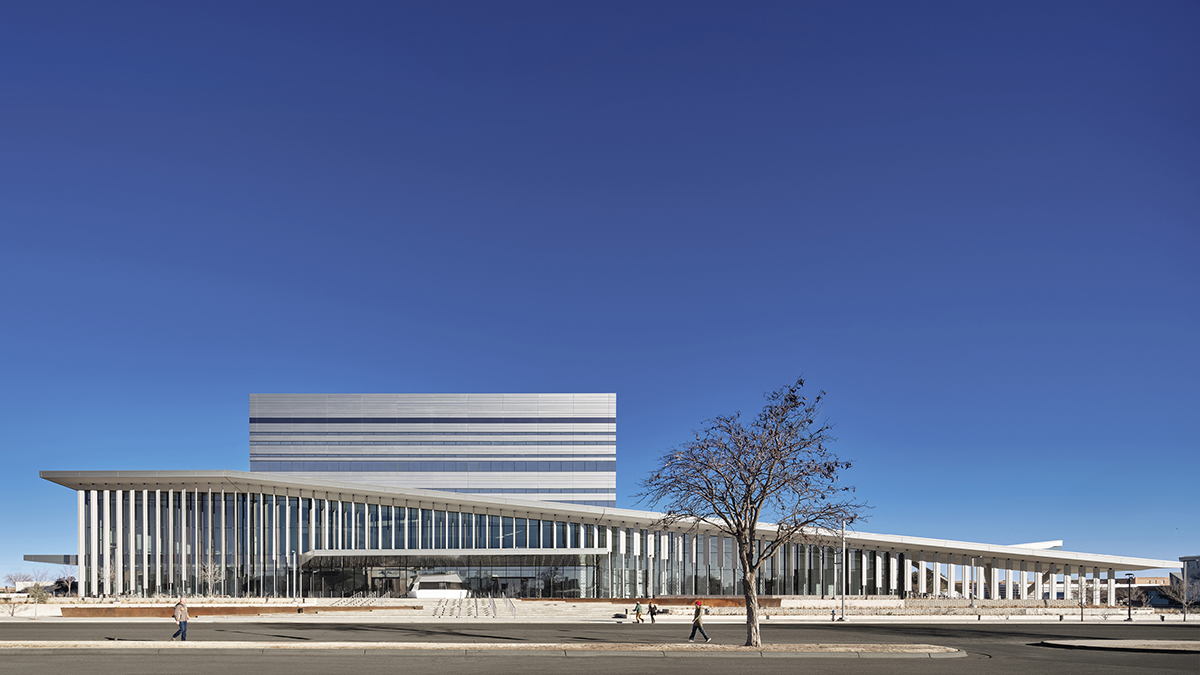
Photo Credit: Casey Dunn
Lubbock, Texas lost its heart after two tornadoes destroyed the downtown core in 1970. Buddy Holly Hall represents a city redefining itself through collaborative design and a community funded commitment to the arts and education. The design is influenced by the landscape of West Texas. Horizontal striations running along the building’s envelope reflect the prismatic rock formations of Texas’ canyons. The building’s colours are inspired by the desert plants, soil, and sky, while its shapes and angles are abstractions of arroyos and other landforms.
Centennial College Downsview Campus Centre for Aerospace and Aviation (Toronto) by MacLennan Jaunkalns Miller Architects Ltd. In association with Stantec Architecture Ltd.
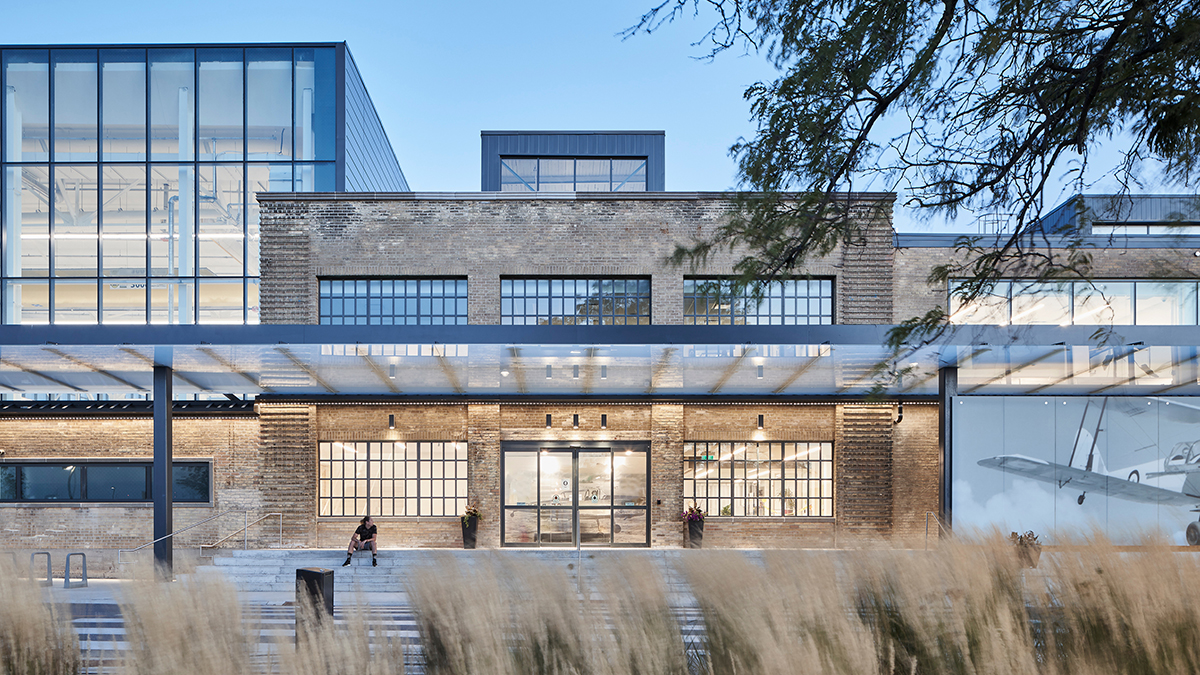 Photo Credit: doublespace photography
Photo Credit: doublespace photography
This adaptive reuse houses the Aviation and Engineering Technology & Applied Science program at Centennial College’s Downsview campus on a site that was once Canada’s epicentre of aviation design and manufacturing. The College’s educational programs are housed inside the heritage structure and new extensions; the complex comprises two hangars, classrooms, admin offices, a library, and learning and fabrication spaces that include avionics, electronics, engines, and composite labs, and group study and collaborative zones. The new facility establishes a museum of artifacts with a collection drawn from the site’s storied past and exhibits conveying the history of Canadian aviation.
Clearview Public Library, Stayner Branch (Stayner, Ontario) by Lebel & Bouliane Inc.
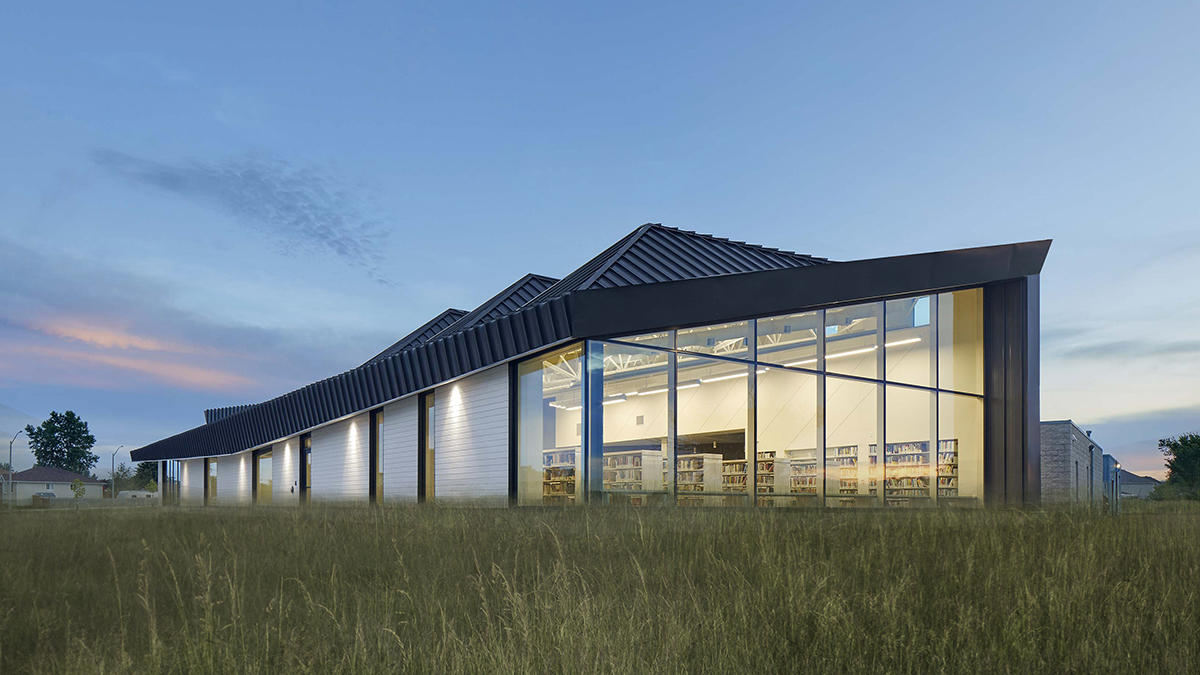 Photo Credit: Tom Arban
Photo Credit: Tom Arban
Clearview’s newest public library is a key project for Stayner’s community. A recipient of this year’s Ontario Library Association (OLA) awards, the library’s energized design language is a result of optimized programming integrated to passive environmental strategies. A modest 650 m2 in area, the library building is thoughtfully connected to the local hockey arena with a small atrium and shared amenities. This result is a bright and airy family-friendly, locally scaled community hub with a powerful and iconic presence. With its folding rooflines, jagged clerestories, enormous views, and powerful design language, the complex is deeply connected to the surrounding landscape.
Craven Road Micro House (Toronto) by Anya Moryoussef Architect
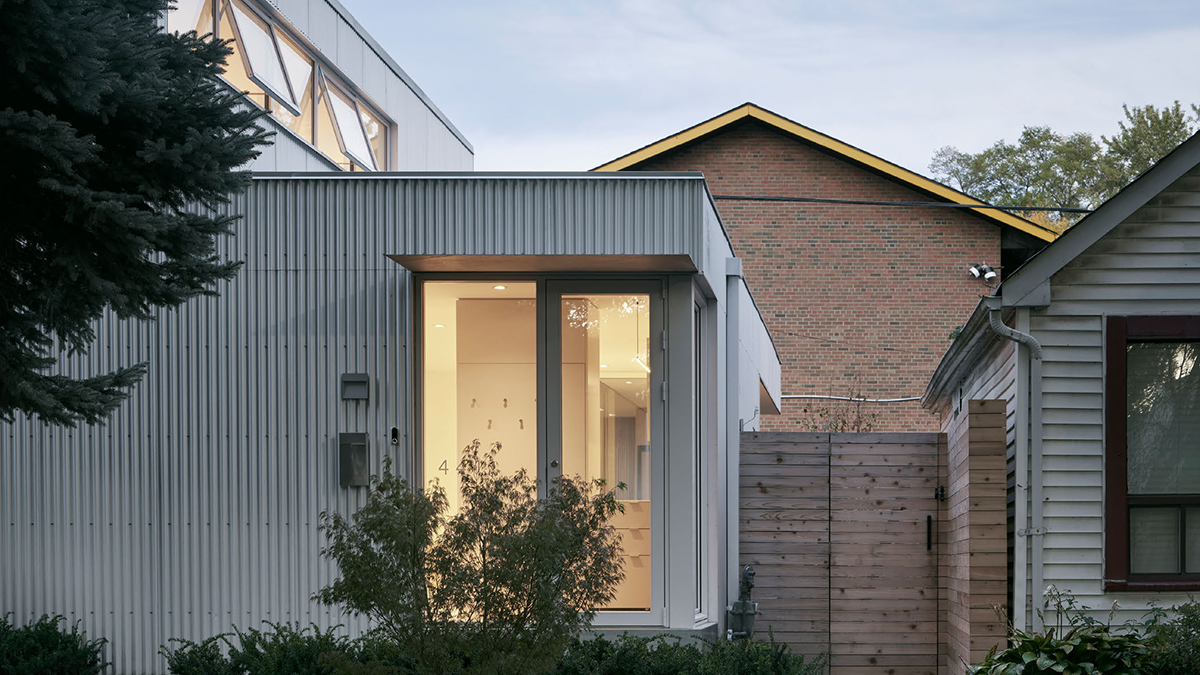 Photo Credit: doublespace photography
Photo Credit: doublespace photography
Commissioned by a retired schoolteacher, AM_A’s Micro House is a highly inventive transformation of a single-storey worker’s cottage on Craven Road, a street featuring some of the smallest houses in Toronto, and a unique architectural outpost in an increasingly unaffordable city. The light-filled, ethereal refuge engenders a sense of expansiveness and well-being through the strategic interplay of volumes and apertures, connecting the house to the outdoors without sacrificing privacy. The small home is an intimate expression of the client, and its sensitive approach to aging-in-place is intended to allow her to remain in her close-knit community for years to come.
m.o.r.e. Cabin (La Peche, Quebec) by Kariouk Architects
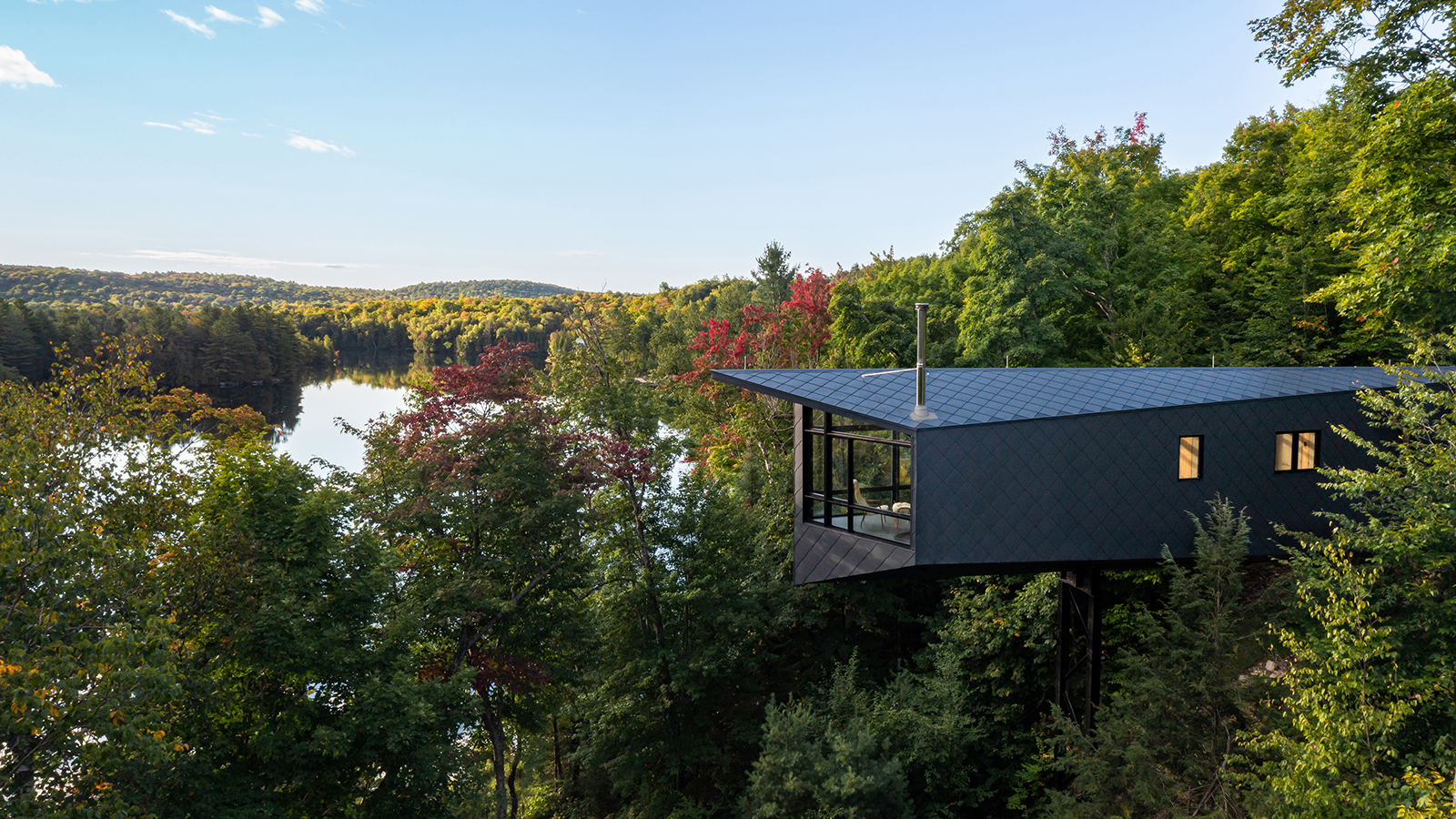 Photo Credit: Scott Norsworthy
Photo Credit: Scott Norsworthy
Most North American cottages look like they’re at one with the landscape, but they’re just as unsustainable as other homes. While m.o.r.e. Cabin is physically separated from the landscape, it’s much kinder to the environment. Cantilevered over a lakeside landscape outside La Pêche, Québec, m.o.r.e. Cabin preserves as much of the forest habitat as possible—after all, that’s why we have cottages in the first place. It also addresses carbon emissions, construction materials, and processes. It even provides a home for endangered local brown bats.
Ontario Tech University Shawenjigewining Hall (Oshawa, Ontario) by Montgomery Sisam Architects in joint venture with Architecture Counsel Inc.
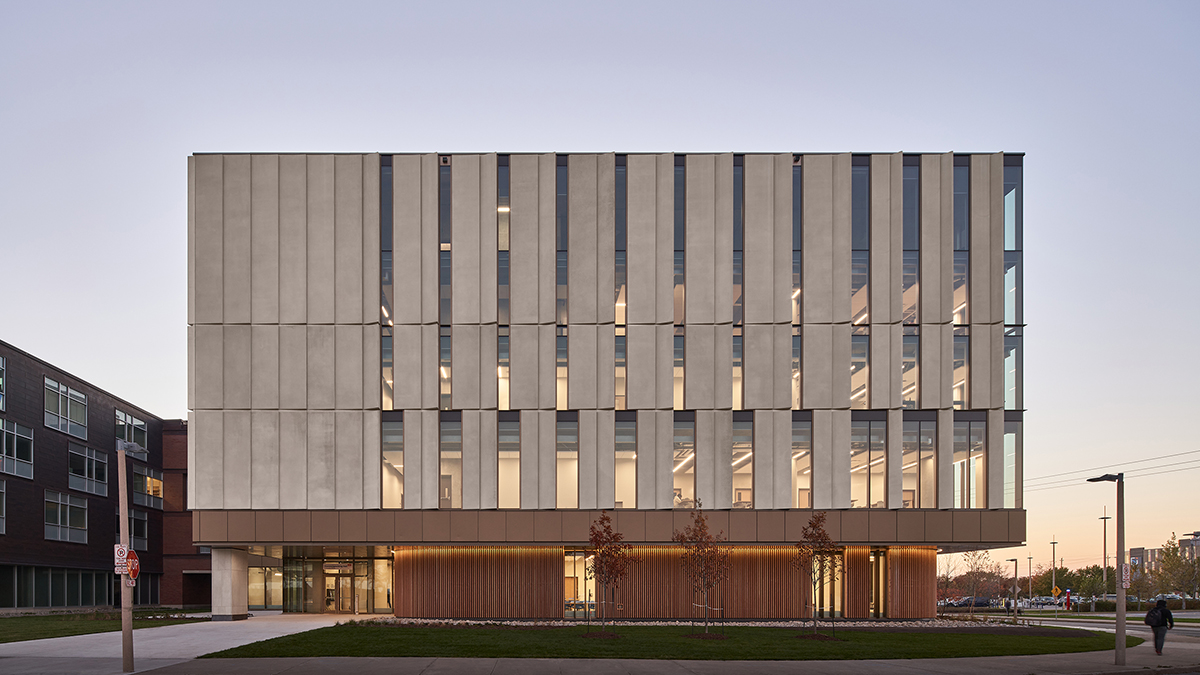 Photo Credit: Younes Bounhar
Photo Credit: Younes Bounhar
Shawenjigewining (pronounced “zha-wen-ji-GEH’-win-ing”) is an Anishinaabe word meaning “The Kind Place.” True to its moniker, Shawenjigewining Hall is a home-away-from-home for every student on this commuter campus. The five-storey, 7,432-m2 building delivers a wide range of student-centred functions. These functions converge around a large open atrium—the ultimate collision space—whose energy activates not only the building core, but also its perimeter, the streetscape, and the adjoining commons. Inside and out, a sophisticated manipulation of simple elements—volume and void, light and shadow—create compelling, memorable qualities of space and a rich diversity of experiences.
Orillia Community Recreation Centre (Orillia, Ontario) by MacLennan Jaunkalns Miller Architects Ltd.
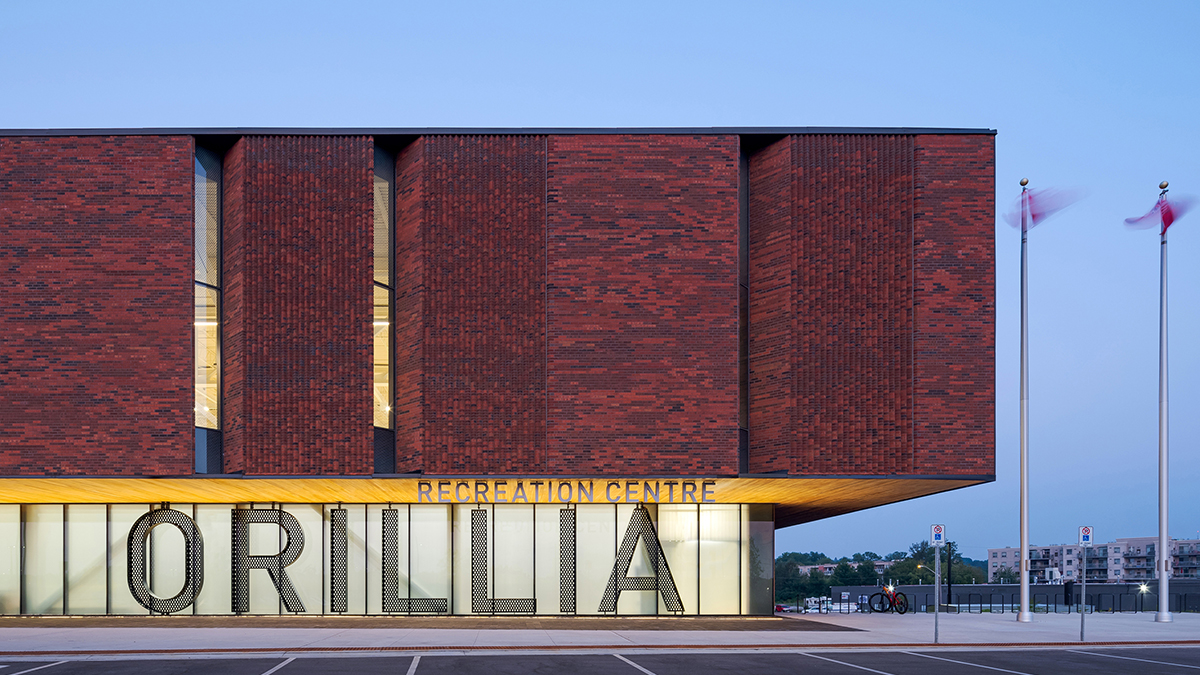 Photo Credit: Scott Norsworthy
Photo Credit: Scott Norsworthy
This re-inhabitation and reclamation of an industrial brownfield site creates a new recreational and social heart for the City of Orillia. The project reimagines Orillia’s storied industrial past and references both the site’s previous use as a foundry and the City’s legacy of brick civic buildings. This 100,000-sf facility includes aquatics, fitness, multipurpose spaces, a double gym/performance space, a community art gallery, and indoor track, with a connective tissue of civic spaces. The built form of the facility is integrated into a 26-acre naturalized park that includes a wetland and is connected to the City’s trail system.
The Osler Bluff Ski Club (Town of the Blue Mountains, Ontario) by Williamson Williamson Inc.
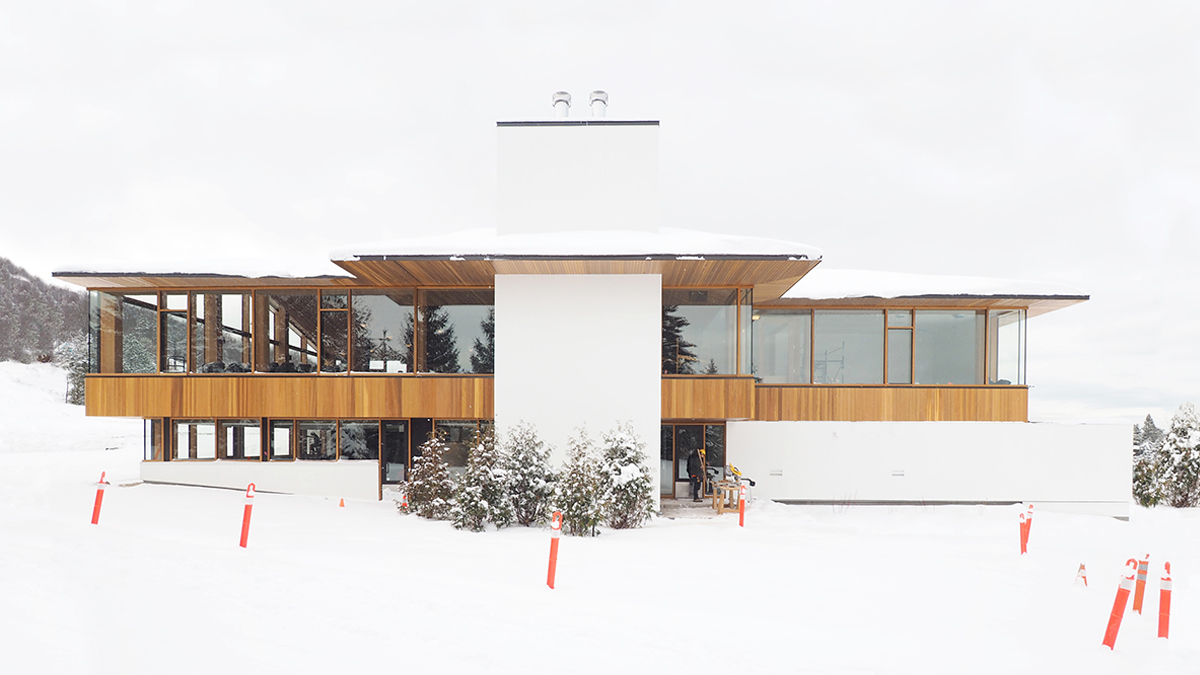 Photo Credit: Williamson Williamson
Photo Credit: Williamson Williamson
The Osler Bluff Ski Club is a renovation and addition onto a rustic 1974, heavy-timber structure. The addition mimics the existing gabled Clubhouse in a modern way and contains a new Great Room, Membership Hub, and Childminding Centre. The design ties together the old and new structures to capture the chalet spirit of the existing spaces. Wood-clad Y-Columns reinterpret the heavy timber structure and mimic the soft profiles discovered through the history of hand-carved skis. A custom Douglas Fir acoustic ceiling conceals services and unifies the interior spaces to create a warm and comfortable space for members of every age to enjoy with their families and friends.
Ottawa Art Gallery Expansion (Ottawa) by Barry Padolsky Associates Inc. Architects and KPMB Architects (advocate architects) / EBC Inc., DevMcGill, and Groupe Germain with Régis Côté et Associés (DBFM consortium) / LEMAYMICHAUD (private-sector tower architects)
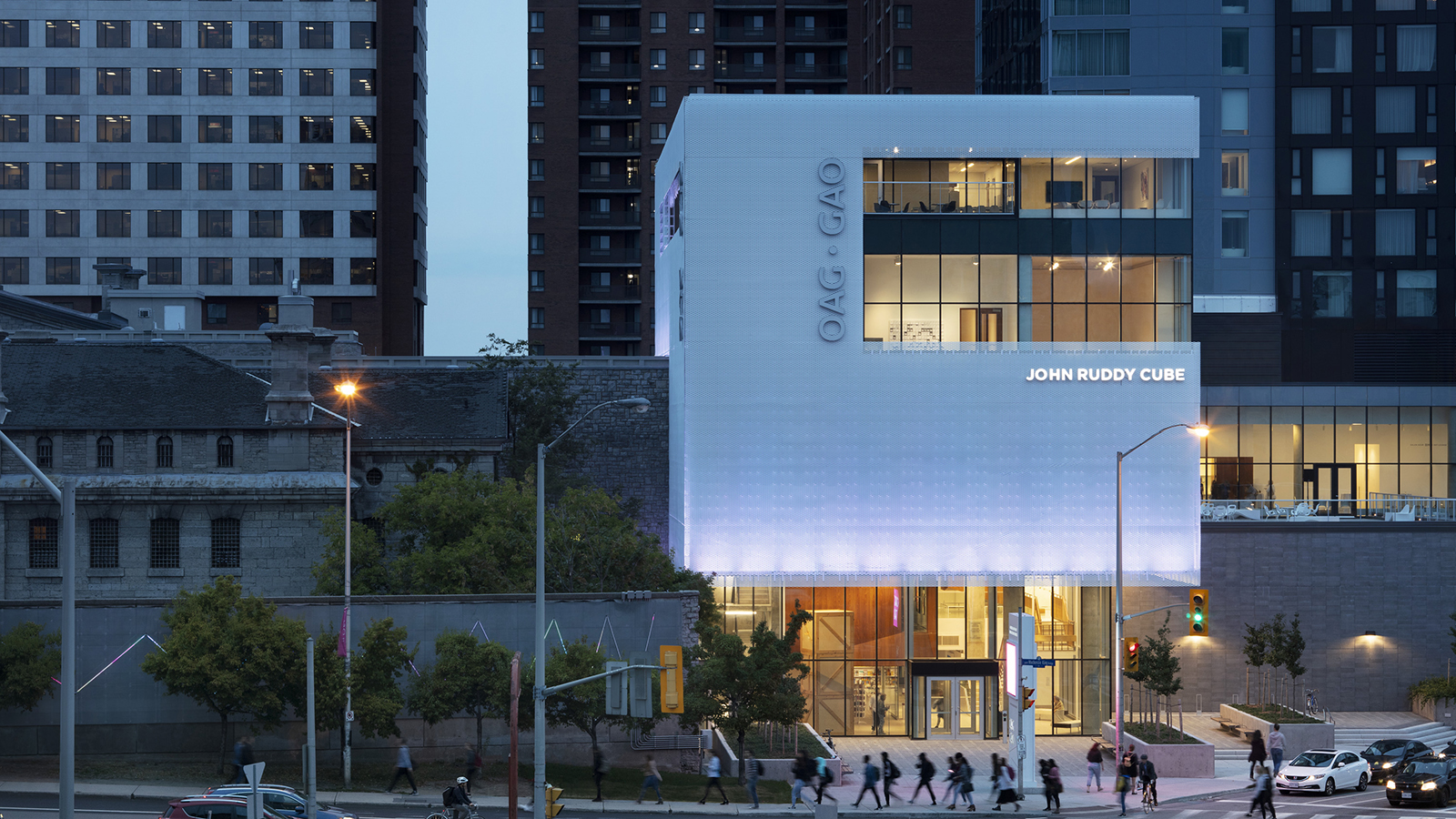 Photo Credit: Adrien Williams
Photo Credit: Adrien Williams
The OAG is an essential component of a mixed-use development that will see the downtown core of Ottawa transformed by the advent of its first light-rail transit. Purpose-built to showcase the arts of the Ottawa and Gatineau region, the new gallery realizes a decade-long dream for a standalone, state-of-the-art museum. The architecture exemplifies the idea of the museum as a social gathering place. The white cubist form achieves a bold, visible and contemporary architectural presence for the OAG within the urban fabric of glass office towers and 19th-century stone and brick masonry buildings.
SmartVMC Bus Terminal (Vaughan, Ontario) by Diamond and Schmitt Architects Incorporated
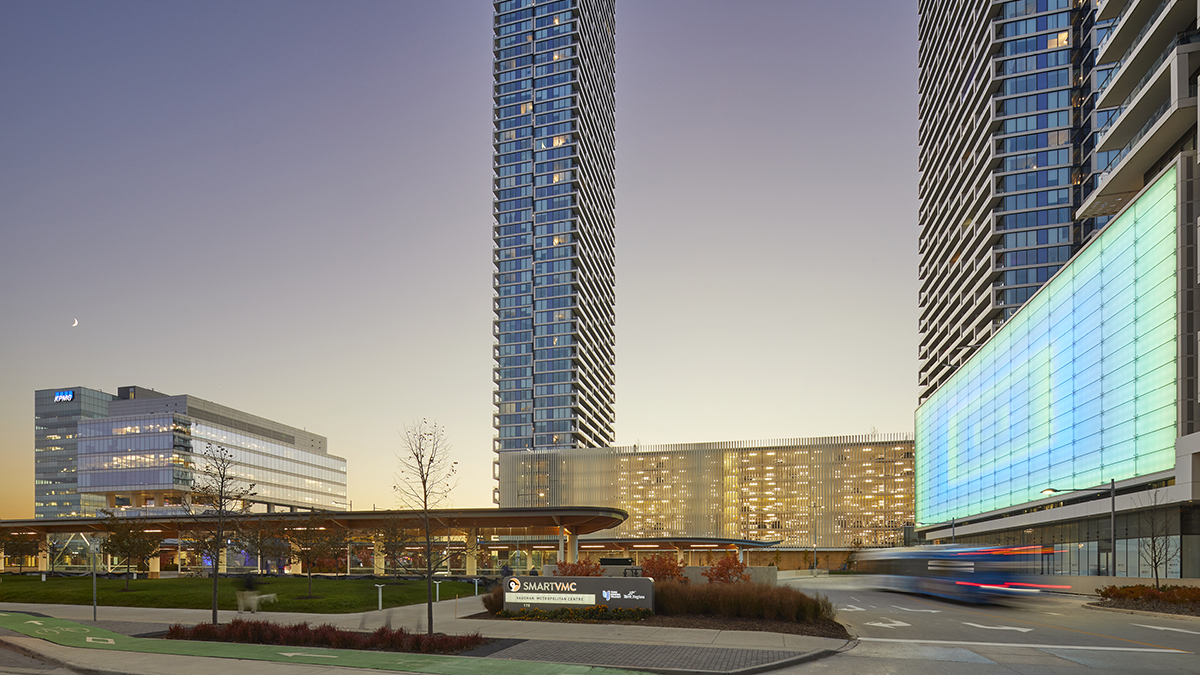 Photo Credit: Tom Arban
Photo Credit: Tom Arban
The SmartVMC is a mixed-use community emerging in Vaughn. Positioned at the terminal station of the Toronto-York Spadina subway extension, it is home to York Region Transit’s new transportation hub. The development's centrepiece is a mass timber bus terminal set within an urban park. The terminal inverts convention by enveloping the bus loop in public space. The PXL Gallery, a 10,000-sf programmable light installation delineates the northern edge of the park while providing commuters with a rotating program of exhibitions. The project points the way to a low-carbon future that embraces civic excellence and architectural expression.
The Springdale Library and Komagata Maru Park (Brampton, Ontario) by RDH Architects Inc.
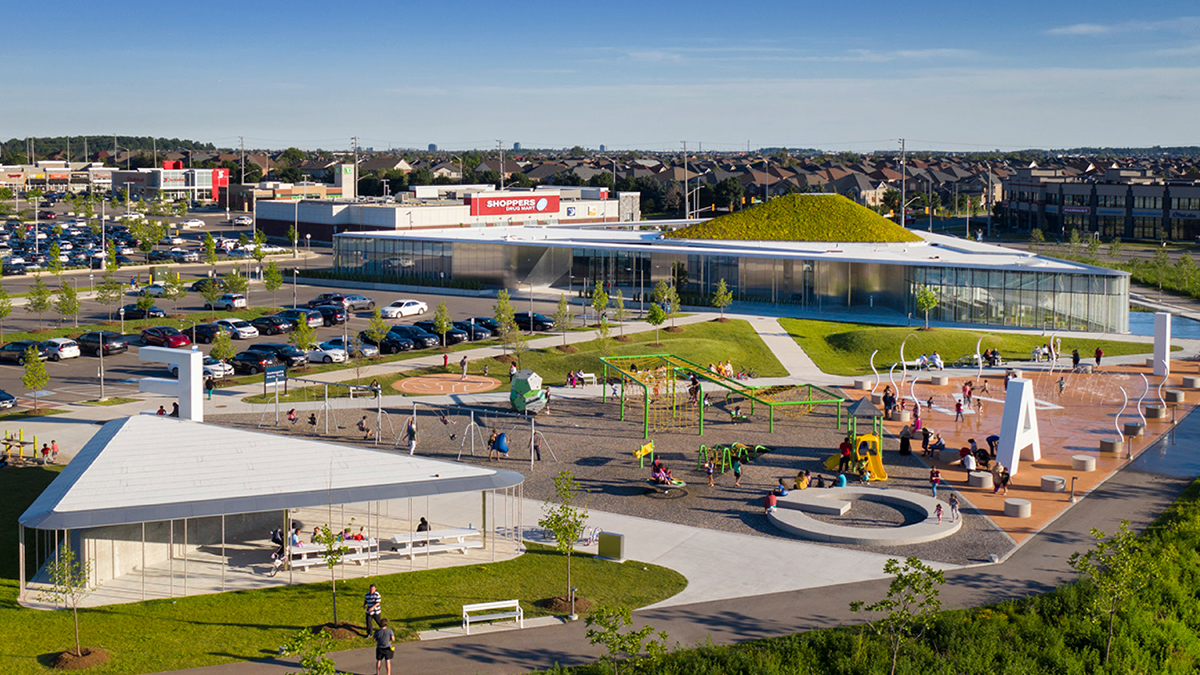 Photo Credit: Nic Lehoux
Photo Credit: Nic Lehoux
The Springdale Library and Komagata Maru Park aspires to create an inclusive gathering place, a progressive architectural expression in the suburbs, and a point of pride for the city. The concept for this project is to establish a new type of suburban landscape through the organically shaped perimeter of the building; the creation of an undulating topography of fluid ceilings and mountainous green roof; and the sectional variation of the ground plane. The new Springdale branch provides Brampton with an emboldened organic presence and a sustainable public resource for the community.
Tile House (Toronto) by Kohn Shnier Architects
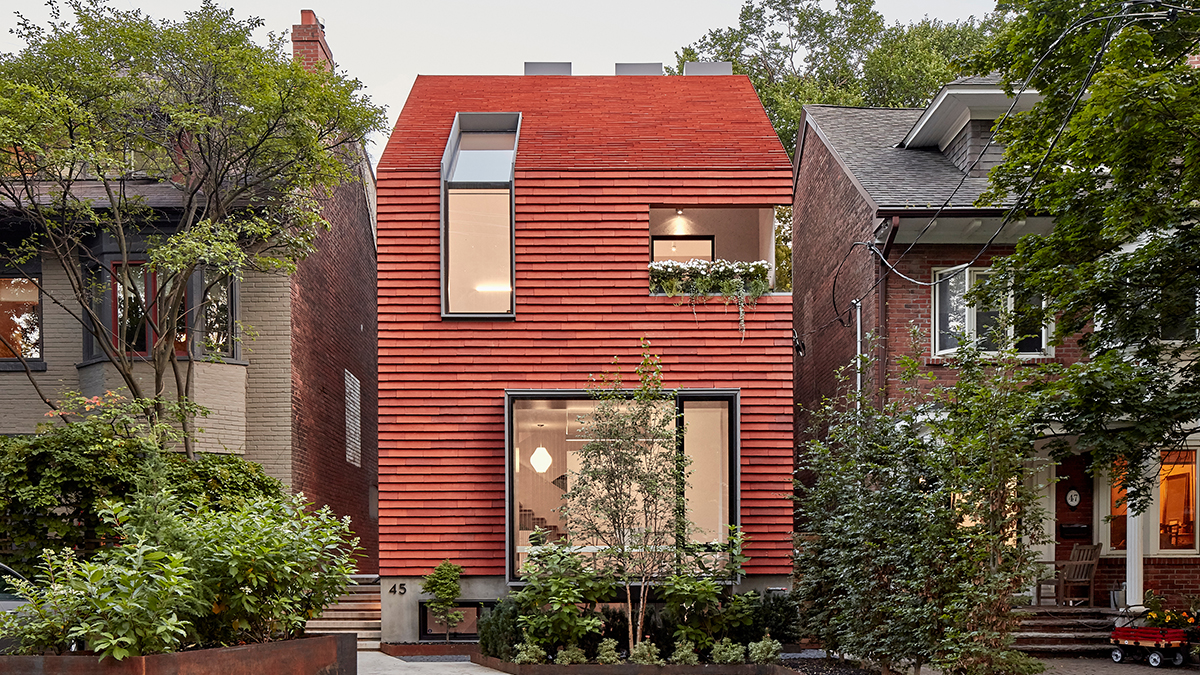 Photo Credit: Michael van Leur
Photo Credit: Michael van Leur
The Tile House is located on a well-established street populated by older homes in mid-town Toronto. The design of the house seeks to find the ‘sweet spot’ between formal innovations that break with conventional boundaries yet respects and reacts to the essential qualities of its context. The exaggerated shadows and minimal material palette of the clay-tile ensure this house is distinct without being abstentious or trendy. It is innovative and assertive, yet modest and familiar. It is a home that will always be understood as both of its time; and a classic.
Tom Patterson Theatre (Stratford, Ontario) by Hariri Pontarini Architects
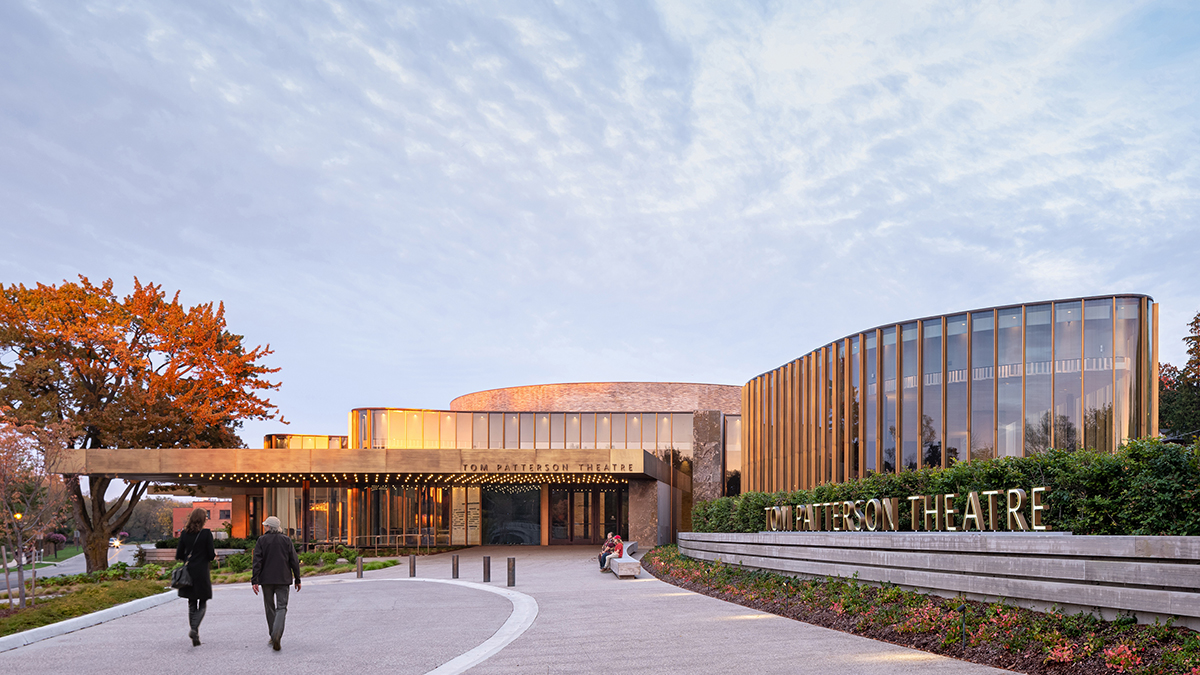 Photo Credit: Scott Norsworthy
Photo Credit: Scott Norsworthy
The new Tom Patterson Theatre at the Stratford Festival is designed to stand as an attractor along the banks of the Avon River. Set within significant gardens, a shimmering bronze veil enwraps the building in warmth and light. Surrounding the intimate auditorium, the lobby, café, education lab, lounge, and forum are light-filled spaces that bring garden and river views deep inside. Both highly sustainable and accessible, this cultural beacon will serve the Stratford Festival for decades to come.
Tommy Thompson Park Entrance Pavilion (Toronto) by DTAH Architects Limited
 Photo Credit: Scott Norsworthy
Photo Credit: Scott Norsworthy
Located in Toronto’s Port Lands Precinct, Tommy Thompson Park is a unique urban wilderness minutes from downtown, located on a manmade peninsula known as the Leslie Street Spit. The Tommy Thompson Park Entrance Pavilion establishes a new front door to the park that is welcoming, engaging, and ecologically sensitive to its context. Serving as a centre for discovery and education, the entrance pavilion is designed as a simple, yet elegant form split in two halves, covered by an expansive cantilevered roof. One half of the structure houses public accessible washrooms, while the other contains administrative spaces that support on-site educational programming.
University College Revitalization (Toronto) by Kohn Shnier Architects in association with E.R.A. Architects Inc.
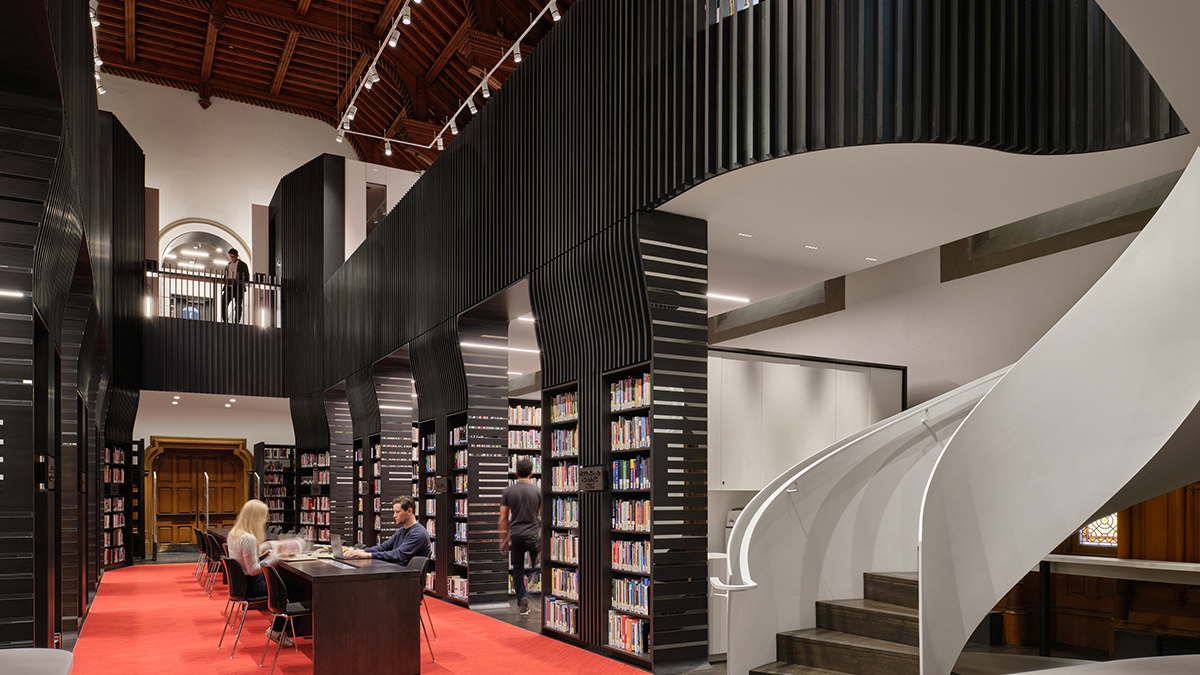 Photo Credit: doublespace photography
Photo Credit: doublespace photography
This project is the strategic and surgical revitalization of University College—an iconic landmark and one of the oldest buildings at the University of Toronto. The keystone of the project is the re-introduction of the University College Library into the two historic Great Halls located on the second level of the building, where the library had originally existed prior to the fire of 1890. This was a project with many design mandates, but most significantly, the design addresses the building’s history as inaccessible. The project dismantles the legacy of physical barriers by celebrating the architectural insertions that achieve it.
University of Toronto Myhal Centre for Engineering Innovation and Entrepreneurship (Toronto) by Montgomery Sisam Architects Inc. in association with Feilden Clegg Bradley Studios
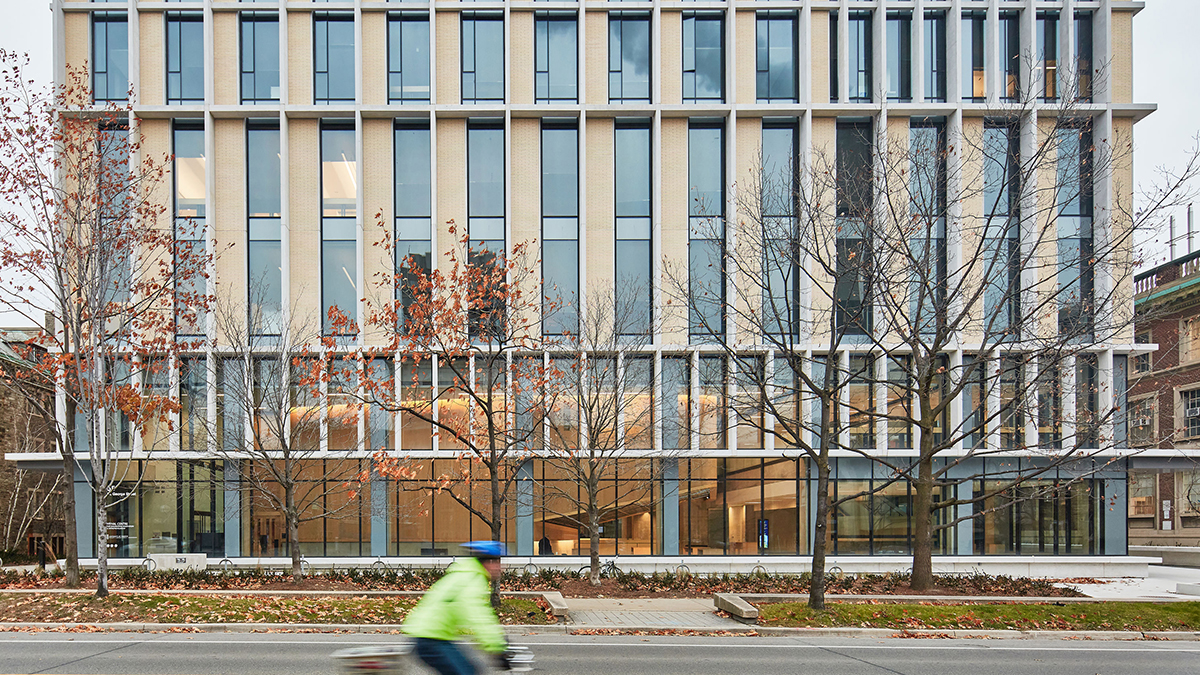 Photo Credit: Tom Rideout
Photo Credit: Tom Rideout
The Myhal Centre heralds a new era in engineering education at the University of Toronto. The 12,920-m2 multidisciplinary teaching and research hub features a progressive blend of formal and informal learning spaces to create an ideal ecosystem for creativity, cross-pollination, and a more complete student life. The building is disciplined in its expression in deference to its many notable neighbours—each façade a simple yet elegant response to its unique bioclimatic condition. The design conjures a sense of awe in its sophisticated stacking of three major voids topped by six conical light shifts that drive daylight deep into its core.
Visitor Education Centre at Canadian National Vimy Memorial (Nord-Pas-de-Calais, France) by Robertson Martin Architects Incorporated and John Lampros Architect
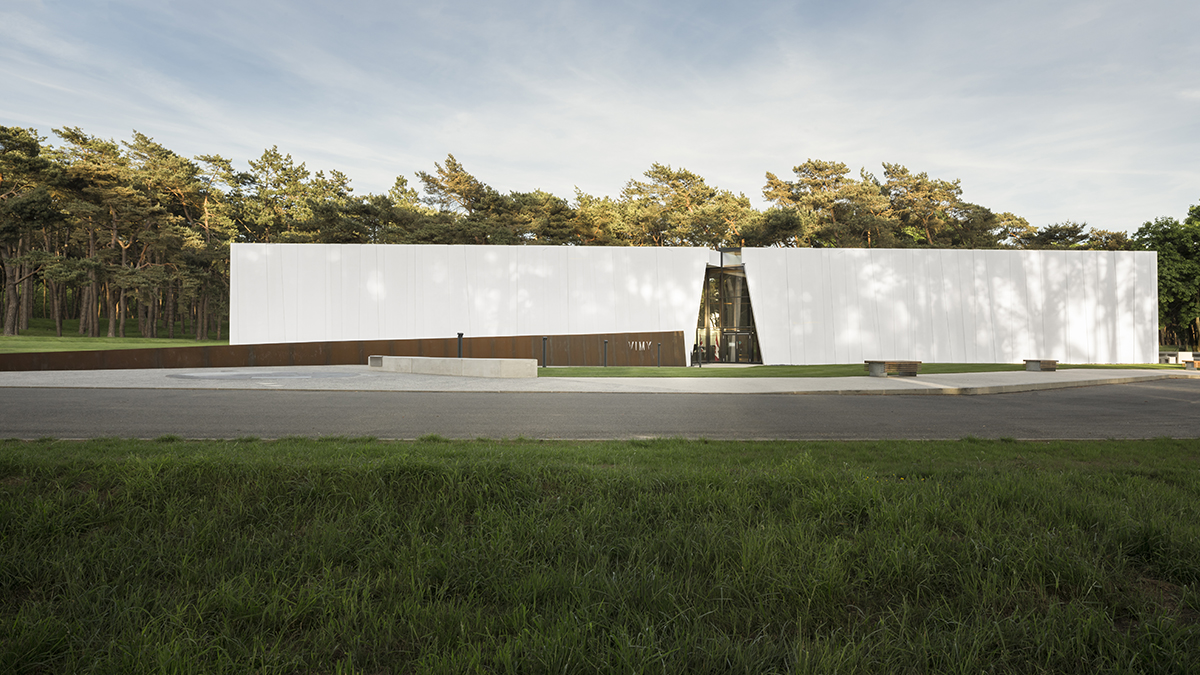 Photo Credit: Stephane Groleau
Photo Credit: Stephane Groleau
For the Canadian National Vimy Memorial Visitor Education Centre, within a National Historic Site, the central challenge was “How does one commemorate today?” Maintaining the visual primacy of the Memorial and the sightlines of two allées inscribed in the landscape, inspired by careful historic analysis, visitors engage with multiple readings of history and memory. An ‘axis of history’, representing frontline trenches intersects with an ‘axis of memory’ toward the monument. Entering through an exterior cleft in the solid mass contrasts with the expansive interior light-filled views of interpretive artifacts and exhibits overlooking preserved, cratered, and wooded battlefield terrain.
The final Design Excellence Winners—as well as the recipients of the Best Emerging Practice, G. Randy Roberts Service Award, Lifetime Design Achievement Award, and Order of da Vinci—will be announced in early April. They will be honoured at the OAA Conference in Toronto, along with the unveiled winners of the Michael V. and Wanda Plachta Award, the Lieutenant Governor's Award for Design Excellence in Architecture, and the People’s Choice Award, which asks members of the public to vote for their favourite Winner.
Profiles of the 17 Finalists will be posted on the OAA Website throughout the rest of March, published in the Awards 2022 book, and shared on Twitter and Instagram.
To see the
2020 winners, you can read the
Awards book or watch that year’s
Celebration of Excellence.